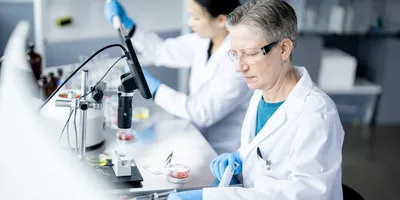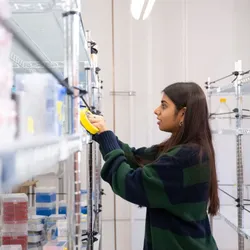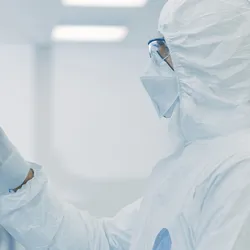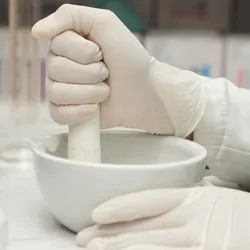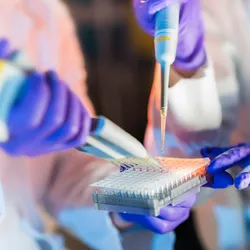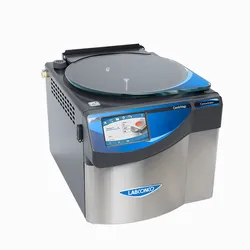Pipetting is a fundamental lab task, but it can quickly escalate into a source of frustration and inefficiency. Manual pipetting is both time-consuming and labor-intensive, involving repetitive motions that can lead to discomfort, fatigue, and even injuries. Ensuring accuracy and precision is a persistent challenge, especially when working with challenging liquids like viscous, volatile, or foaming media.
Choosing the right liquid handling technology can help labs address the limitations of challenging media and repetitive tasks, ultimately enhancing accuracy, precision, efficiency, and ergonomics.
Air displacement versus positive displacement pipettes
Look around any life science lab, and you’ll likely find an air displacement pipette. These easy-to-use devices employ an air cushion between the piston (located in the pipette shaft) and the liquid, minimizing contamination. During aspiration, the piston displaces an air volume equal to the desired liquid volume, creating a partial vacuum that draws liquid into the tip. Dispensing works in reverse, with the piston generating a positive pressure that expels the liquid. A final blow-out step then removes any residual liquid.
The air cushion can be influenced by the liquid’s properties, leading to problems with accuracy and precision, particularly for viscous, foaming, and volatile liquids. Detergents or protein-rich solutions, such as BSA, foam readily during aspiration. This introduces air bubbles that can contaminate the pipette shaft and alter the dispensing volume, making complete expulsion challenging. Viscous liquids, like glycerol, flow slowly and tend to cling to the pipette tip, leading to incomplete aspiration and dispensing. Furthermore, calibration is typically performed using room-temperature distilled water. Liquids with different properties may require recalibration, making these pipettes best suited for liquids similar to water.
Positive displacement pipettes take a different approach. The piston comes in direct contact with the liquid and is part of a specialized capillary tip, eliminating the air cushion and preventing pipette contamination. During aspiration, the piston rises, creating space for the incoming liquid. Dispensing then involves the tightly fitted piston displacing the liquid, guaranteeing complete expulsion without a separate blow-out step. This method ensures accuracy and reproducibility, regardless of the liquid, making these pipettes ideal for more challenging liquids like viscous and foaming solutions. Additionally, the reduced impact of the liquid simplifies calibration. However, the specialized tips are more expensive and require a more laborious tip-changing process than air displacement pipettes.
Taking the pain out of pipetting
With prolonged and repeated use, manual pipettes can lead to various muscular problems, collectively known as repetitive strain injuries (RSIs). Ergonomic pipette designs that are lightweight and reduce the force required to grip and operate these devices, along with following best practices—such as regular breaks and proper hand positioning—can help mitigate these risks. To further protect against RSIs, lab personnel should minimize the number of pipetting steps with multichannel and repetitive pipettes, and reduce operational force by using electronic pipettes with automated pipetting functions. The most effective solution combines these strategies, leveraging modern, lightweight electronic pipettes with improved ergonomics and functionality.
Rather than the typical plunger, volume adjustment dial, and tip ejector button, electronic pipettes employ digital controls for aspiration and dispensing, minimizing physical strain and the risk of RSIs. Some electronic pipettes also offer various pipetting modes, such as multi-dispensing and auto-dispensing. These functions eliminate the need for repeated intake, improving efficiency and reducing user fatigue. However, it’s important to note that electronic air displacement pipettes, while capable of dispensing partial volumes, lack the accuracy required for multi-dispensing. For such tasks, electronic repetitive pipettes, which are mostly positive displacement pipettes, offer superior accuracy.
Combining precision, comfort, and convenience
A new generation of electronic repetitive pipettes offers a powerful combination of ergonomics and versatility. These instruments leverage the accuracy and precision of positive displacement technology to tackle your toughest pipetting challenges, from handling viscous and foaming liquids to complex repeating functions.
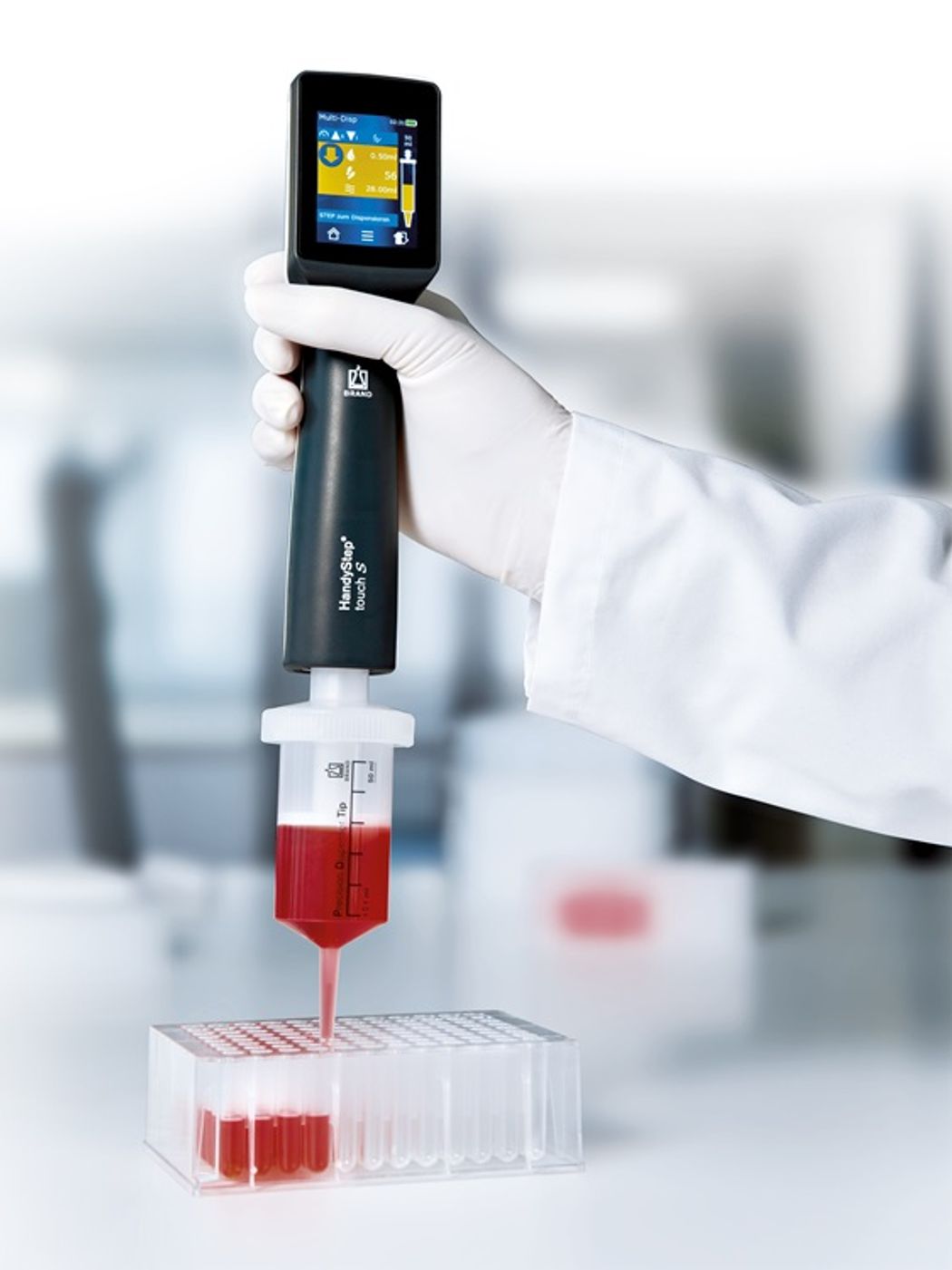
Credit: BrandTech
The large, intuitive touchscreen display on the HandyStep® touch electronic repetitive pipettes from BRANDTECH® lets users swipe between functions, just like on a smartphone, even while wearing gloves. This smart display makes operation easy and keeps essential information at your fingertips, minimizing the force required. As a satisfied user from a government lab said, “It makes our work a lot easier and saves us from having to manually pipette our large-volume assays.” Furthermore, the pipette has a strategically placed button for easy index-finger actuation, along with a lightweight construction made of high-technology polymers and metal components. This ergonomic design minimizes strain and enhances comfort during prolonged use.
With a wide volume range—1.0 μl to 50 ml—and multiple modes, these pipettes offer versatility across many applications. The available modes include pipetting, multi-dispensing of defined volumes, auto-dispensing, sequential dispensing of different volumes, multi-aspiration of different volumes, and titration for both manual and successive liquid delivery. A favorites mode also allows users to save and easily retrieve frequently used protocols for improved efficiency and consistency across experiments. Additionally, the HandyStep® touch pipettes offer eight aspiration and dispensing speeds, perfect for manipulating a variety of liquids, from delicate biological samples to foaming and viscous media.
Instead of interrupting your workflow with time-consuming tip changes, these pipettes use automatic tip ejection to streamline the process. Thanks to the patented encoding on the BRAND® PD-Tips II piston head, the pipettes also instantly recognize the tip size upon insertion. The size is then displayed on the screen, making volume and mode selection a breeze. Plus, if you insert a new PD-Tip of the same size, all your settings stay intact, saving even more time and reducing errors. These instruments are also compatible with tips from various manufacturers for maximum flexibility.
With precision, accuracy, and comfort all rolled into one, the HandyStep® touch electronic repetitive pipettes help make lab work more efficient and enjoyable.
To learn more, visit https://shop.brandtech.com




